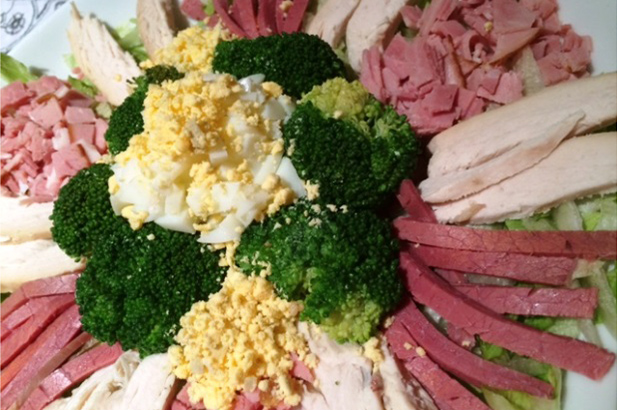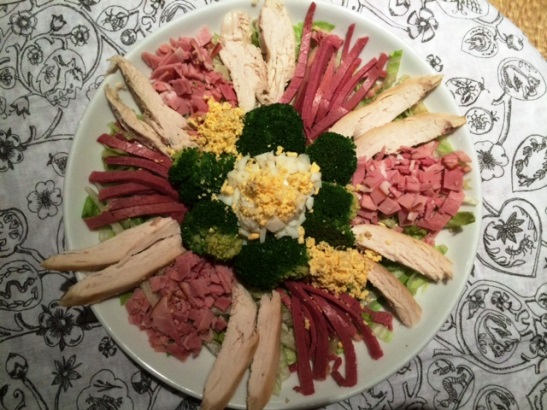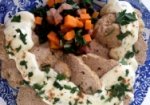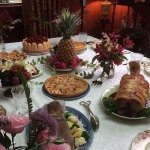Salmagundy, salmagundi, salamongundy, solomon-gundy, there are as many name variations as there are versions of the same theme. Salmagundy is a fine example of what we might now regard as a ‘deconstructed’ or more traditionally, a ‘composed’ salad, with an array of meats or fish, eggs and salad vegetables carefully and artfully displayed for maximum impact at the table. A popular dish in eighteenth- and early nineteenth-century cookbooks, and recommended by ‘Mrs E’ to Maria Macarthur to serve at a formal dinner, salmagundy seems to have disappeared from the menu in Victorian times.
‘According to your Fancy’
The Art of cookery made plain and easy, first published by Hannah Glasse in 1747, but widely consulted well into the 1800s, offers four recipes for ‘salamongundy’. Three are meat and vegetable combinations, the fourth is in the chapter for ‘Fasts’ or Lenten dishes, when meat was off the menu (usually the six weeks leading up to Easter), and features pickled herrings or anchovies. Its appeal is that it is a move-able feast, as ‘you may make a Salamongundy of such things as you have, according to your Fancy’. They’re very easy to assemble, and while a little ‘twee’, a good summer crowd pleaser. This is one of Glasse’s options, and a delightful example of descriptive ‘receipt’ and language use in the 18th century (I’ve added a deciphered version at the end of this post, which has far less charm).
To Make Salamongundy
Take two or three Roman or Cabbage Lettice, and when you have washed them clean, swing them pretty dry in a Cloth; then beginning at the open End, cut them cross-ways, as fine as a good big Thread, and lay the Lettices so cut, about an Inch thick all over the Bottom of the Dish.
When you have thus garnished your Dish, take a Couple of cold roasted Pullets, or Chickens, and cut the Flesh off the Breasts and Wings into Slices, about three Inches long, a Quarter of an Inch broad, and as thin as a Shilling; lay them upon the Lettice round the End to the Middle of the Dish and the other towards the Brim; then having boned and cut six Anchovies each into eight Pieces, lay them all between each Slice of the Fowls, then cut the lean Meat of the Legs into Dice, and cut a Lemon into small Dice; then mince the Yolks of four Eggs, three or four Anchovies, and a little Parsley, and make a round Heap of these in your Dish, piling it up in the Form of a Sugar-loaf, and garnish it with Onions, as big as the Yolk of Eggs, boiled in a good deal of Water very tender and white. Put the largest of the Onions in the Middle on the Top of the Salamongundy, and lay the rest all round the Brim of the Dish, as thick as you can lay them; then beat some Sallat-Oil up with Vinegar, Salt and Pepper and pour over it all.
Garnish with Grapes just scalded, or French beans blanched, or Station Flowers [nasturtiums], and serve it up for a first Course.
Fancy, indeed
The distinguishing characteristic that sets Salmagundy apart from regular salads, is that the individual ingredients are kept separate from each other, rather than mixed or tossed through as a whole. They could be kept fairly plain and practical, arranged on a single plate in colourful rows or circles or tricked up, sometimes taking centre stage as an ornate centrepiece on the table, decorated with edible flowers scattered throughout. Hannah Glasse suggests that each ingredient could be placed in a small decorative dish and arranged in circular tiers on the table, each round elevated on an inverted saucer or tea cup (which sounds a bit precarious, especially serving from it!). For those without the appropriate dishes or sculptural acumen, Maria Rundell, in A new system of domestic cookery (1816/1871) suggests presenting finely chopped or minced fillings of different colours and textures in the whites from hard boiled eggs rather than crockery. Samagundy might these days be the perfect use for those sectioned dish sets you so often see ‘pre-loved’ at op-shops, or ‘chip and dip’ platters that have a central section for the star ingredient.
Echoes of the past
I tend to think that salmagundy is still with us in slightly different forms – as Italian-style antipasto, with its colourful mixture of cured meats and vegetables or an Indonesian gado-gado, traditionally a selection of fresh or blanched vegetables (often including potatoes and green beans), hard boiled eggs, tofu and for meat eaters, prawns or chicken, dressed with a rich peanut sauce. Some link the name of the dish (and therefore perhaps the dish itself?) to the French, salmi meaning salt-cured meat or later, and by the 1760s according to the Online etimology dictionary, the term meant ‘a mixture of various ingredients’. It has been suggested that Salad Nicoise may also have common origins, typically made with potatoes, green beans, olives and hard-boiled eggs, substituting fish for cured meats, which makes some sense, given Nice’s coastal location, but doesn’t really qualify in my mind, as the ingredients are presented all mixed together.
Salmagundy
Ingredients
- 1 cos lettuce, leaves washed, dried and shredded
- cold, cooked chicken breast fillet
- cold, cooked chicken thigh and leg meat, chopped
- 12 anchovy fillets, drained
- 4 hard-boiled eggs
- 1 anchovy fillet, finely chopped
- 1 thin-skinned lemon, finely chopped
- curly parsley, finely chopped
- 10 green and/or yellow beans, blanched
- 1 small white 'spring' or salad onions, blanched (or white cocktail onions)
- nasturtium flowers
- oil & vinegar salad dressing
Note
This Salmagundy recipe is taken from one of Hannah Glasse’s ‘salamongundy’ receipts from 1747. Feel free to substitute the ingredients for whatever is at hand, but using a variety of colours, form and textures.
Directions
| Cover the base of a round serving platter with the shredded lettuce. Slice the chicken breasts into slender finger-like lengths and arrange in five 'spokes' from the centre to the edge of the dish. Arrange the anchovy fillets in a similar fashion, laying them lengthwise between the chicken slices. Chop the beans into small lengths and place them between the chicken and anchovy slices. Remove the yolks from the eggs and mash with the finely chopped anchovy, lemon and parsley, and shape into a tall mound and place in the centre of the dish. Chop the egg whites and scatter around the edge of the mashed egg, then arrange the chopped thigh and leg meat in a circle around the whites. Scatter the cocktail onions about the dish, and decorate with nasturtium flowers and petals. | |
| Pour dressing over the salad, or serve separately, for diners to add when serving. | |


 Print recipe
Print recipe

